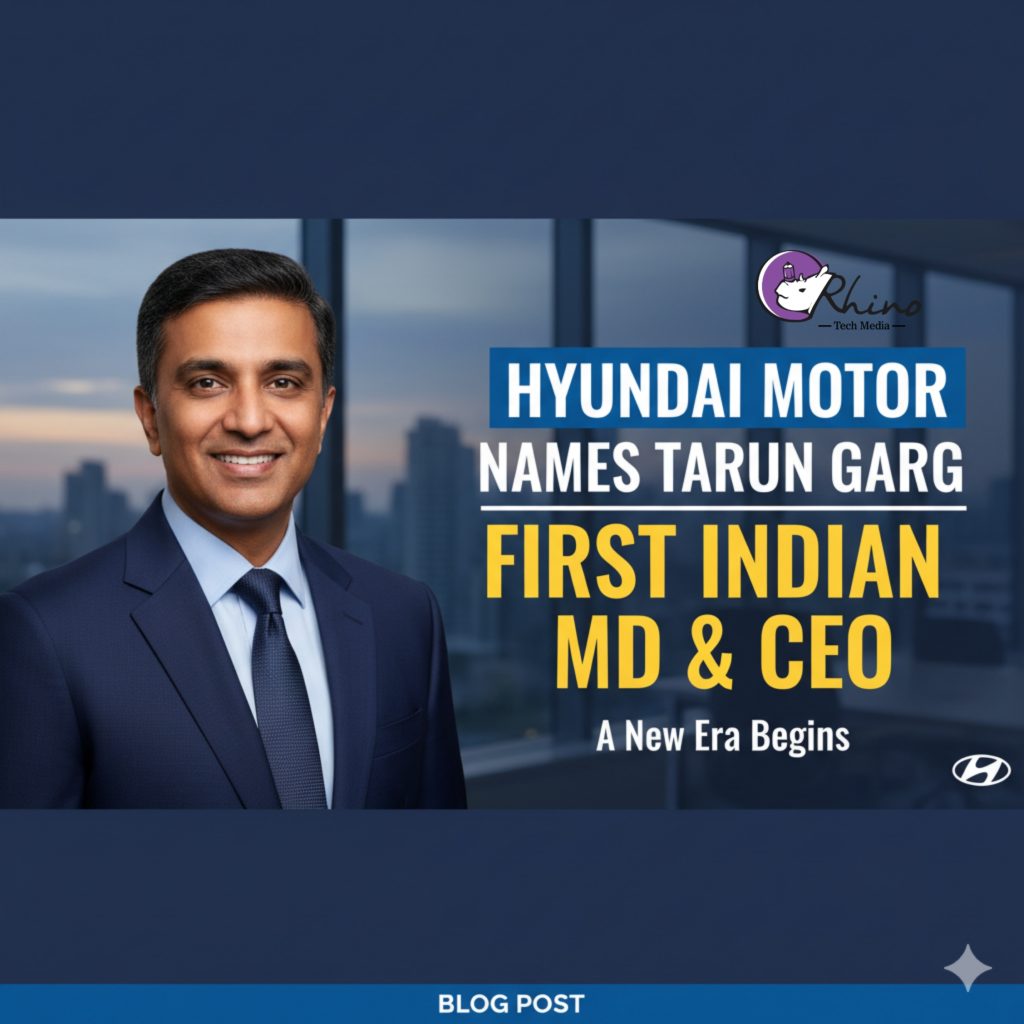In October 2025, Hyundai Motor India Limited (HMIL) announced a landmark leadership change: Tarun Garg, currently the company’s Whole-time Director and Chief Operating Officer, has been named Managing Director & Chief Executive Officer, effective January 1, 2026, following standard shareholder approvals. This decision marks the first time since Hyundai’s Indian operations began in 1996 that an Indian national will head its Indian business.
Who Is Tarun Garg
Tarun Garg comes with deep roots in the Indian automotive sector. His foundational training is mechanical engineering from Delhi Technological University (formerly Delhi College of Engineering), and he also holds an MBA from IIM Lucknow.
His career trajectory includes a long stint with Maruti Suzuki India Ltd., where he started as a management trainee and rose through multiple leadership roles: Regional Sales Manager, Commercial Business Head, National Sales & Network Head, and, finally, Executive Director in charge of Marketing, Logistics, Parts & Accessories.
Garg joined Hyundai in late 2019 (December) as Director of Sales, Service & Marketing. In 2023, he was elevated to COO. Over his brief but eventful period at Hyundai, he has been involved in strategic initiatives including:
- introduction of Advanced Driver Assistance Systems (ADAS) in nine Hyundai models
- improving sales quality
- reducing incentives
- boosting profit margins
- expanding reach into rural markets and the used-car segment
- pushing digital marketing and premium channel development.
Transition from Unsoo Kim
Garg succeeds Unsoo Kim, the current MD & CEO, who has overseen Hyundai India since 2022. Unsoo Kim will return to the parent company in South Korea to take up a “strategic role” from December 31, 2025. Until then, Garg will be MD & CEO designate.
Significance of the Appointment
Local Leadership
That an Indian is now being entrusted with the top job is symbolically important. It reflects Hyundai’s confidence in local management, and a recognition that Indian market conditions, customer preferences, regulatory landscapes, and competitive dynamics demand leadership that is rooted in the local environment.
Strategy, Continuity and Evolution
Under Garg, Hyundai India is likely to lean further into strategies he has overseen: focusing on product feature differentiation (like ADAS), realigning pricing/incentives, improving margins, and expanding in under-penetrated areas of the market. The change suggests a continuity of existing gains, while also offering an opportunity to adapt to evolving challenges (competition from domestic and global players, EV adoption, regulatory push towards sustainability, etc.).
Message to Industry & Investors
For investors, employees, suppliers and the broader auto industry, this move signals greater localization not just in manufacturing, but in leadership. It is also aligned with broader trends in multinational companies giving more responsibility to local talent, especially in growing markets such as India. Moreover, it comes alongside a sizeable investment plan by Hyundai India (e.g. capacity, R&D) indicating that the company is preparing for the future in India.
Challenges Ahead
While the appointment is laudable, Garg inherits a complex landscape:
- Competitive pressure: Indian auto market is becoming both more crowded and more demanding: new entrants (particularly in EVs), greater regulation (emission, safety norms), rising customer expectations.
- Margin pressures: As incentives and discounts have been a lever to drive volume, balancing them while maintaining profitability will be tough.
- EV transition & regulation: Adapting to shifting policy landscape (fuel norms, EV incentives, safety standards) will require rapid agility.
- Supply chain & localization: Increasing localisation of components, ensuring quality, keeping costs down, and dealing with semiconductor & other part shortages are not trivial.
- Customer experience & brand perception: Keeping Hyundai’s brand strong in India in terms of reliability, after-sales, technology features, and aligning with aspirations of customers.
What It Means for Hyundai India & the Indian Auto Sector
- Acceleration of R&D and product localization: With Garg’s track record and the new investments being announced, Hyundai is likely to increase its focus on features desired by Indian consumers (e.g. ADAS, connected features), perhaps accelerate EV/Hybrid models localized for Indian conditions.
- Potential for higher organizational autonomy: Local leadership typically allows swifter decision-making responsive to local needs. Garg being Indian could help in smoother coordination with regulators, understanding consumer trends, perhaps even tighter alignment between local and global strategy.
- Signal for other multinationals: Hyundai’s move could push similar companies to reconsider where they deploy leadership in India (and similar markets) — possibly creating more opportunities for domestic executives.
Conclusion
The appointment of Tarun Garg as MD & CEO of Hyundai Motor India is more than just a change of leadership; it marks a maturation of the Indian business for a major global automaker. It mirrors India’s growth importance in the global automotive landscape, the rising demand for localization in leadership, and the need for home-grown insights to steer companies through complexity. Garg’s track record shows he is well-poised to take on the role, but the journey ahead will test how effectively he can balance growth, profitability, innovation, and customer expectations in an increasingly competitive market. Hyundai’s performance under his leadership will be watched closely—not only by competitors, but by consumers, investors, and policymakers alike.

